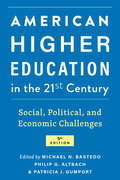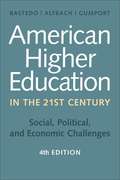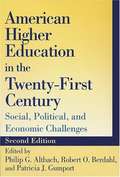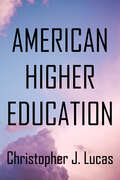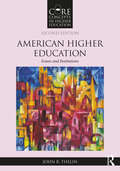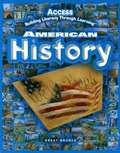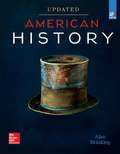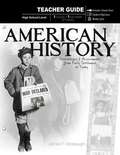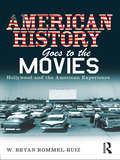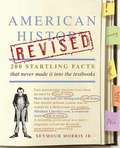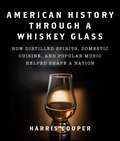- Table View
- List View
American Higher Education in the Twenty-First Century: Social, Political, and Economic Challenges
by Michael N. Bastedo, Philip G. Altbach, and Patricia J. GumportNow in its fifth edition! An indispensable reference for anyone concerned with the future of American colleges and universities.Whether it is advances in information technology, organized social movements, or racial inequality and social class stratification, higher education serves as a lens for examining significant issues within American society. First published in 1998, American Higher Education in the Twenty-First Century offers a comprehensive introduction to the complex realities of American higher education, including its history, financing, governance, and relationship with the states and federal government. This thoroughly revised edition brings the classic volume completely up to date. Each chapter has been rewritten to address major recent issues in higher education, including the COVID-19 pandemic, the movement for racial justice, and turmoil in the for-profit sector. Three entirely new chapters cover broad-access colleges, race and racism, and organized social movements. Reflecting on the implications of ethnic and socioeconomic diversity within higher education, the book also grapples with growing concerns about the responsiveness and future of the academy.No other book covers such wide-ranging issues under the broader theme of higher education's relationship to society. Highly acclaimed and incorporating cutting-edge research, American Higher Education in the Twenty-First Century is now more useful and engaging than ever.Contributors: Michael N. Bastedo, Philip G. Altbach, Patricia J. Gumport, Peter Riley Bahr, Joy Blanchard, Julia Brickfield, Michael Brown, Katherine S. Cho, Daniela Conde, Charles H. F. Davis III, Hans de Wit, Peter D. Eckel, Martin Finkelstein, Denisa Gándara, Liliana M. Garces, Roger L. Geiger, Leslie D. Gonzales, Jillian Leigh Gross, Jessica Harris, Nicholas Hillman, Julia Rose Karpicz, Robert Kelchen, Adrianna Kezar, Lisa R. Lattuca, Demetri Morgan, Rebecca Natow, Anna Neumann, Audrey Peek, Laura W. Perna, Gary Rhoades, Tykeia N. Robinson, Roman Ruiz, Wonson Ryu, Lauren T. Schudde, Jeffrey C. Sun, David A. Tandberg
American Higher Education in the Twenty-First Century: Social, Political, and Economic Challenges FOURTH EDITION
by Philip G. Altbach Patricia J. Gumport Michael N. BastedoFirst published in 1999, American Higher Education in the Twenty-First Century offered a comprehensive introduction to the central issues facing American colleges and universities. This thoroughly revised edition brings the classic volume up to date. The contributors have rewritten every chapter to address major changes in higher education, including the rise of organized social movements, the problem of income inequality and stratification, and the growth of for-profit and distance education. Three new chapters cover information technology, community colleges, and teaching and learning. This edition seeks to capture several crucial dynamics in the nexus of higher education and society. Placing higher education within its social and political contexts, the contributors discuss finance, federal and state governance, faculty, students, curriculum, and academic leadership. They also grapple with growing concerns about the future of the academy and reflect more deeply on the racial, ethnic, and socioeconomic diversity within higher education. No other book covers such wide-ranging issues under the broader theme of higher education's relationship to society. Highly acclaimed and incorporating cutting-edge research, American Higher Education in the Twenty-First Century is now more useful and engaging than ever.
American Higher Education in the Twenty-first Century: Social, Political, And Economic Challenges
by Philip G. Altbach Robert Oliver Berdahl Patricia J. GumportLargely critical of recent attacks on the state of American higher education coming from advocates of privatization, reinventing government, total quality improvement, and so on, the eighteen contributions in this collection are presented by Altbach (higher education, Boston College), Berdahl (emeritus, higher education, U. of Maryland at College Park), and Gumport (education, Stanford U.) as an attempt to situate American higher education in broad social context in order to evaluate the legitimacy of the arguments of its critics. Papers explore the roles of external constituencies such as the federal government, state governments, the courts, and nongovernmental entities; as well as internal constituencies such as the faculty, the students, and administration. Others examine particular issues, including autonomy and accountability, academic freedom, finance, technology, graduate education, the curriculum, race, and the commercialization of higher education. Annotation ©2004 Book News, Inc., Portland, OR (booknews.com)
American Higher Education since World War II: A History (The William G. Bowen Series #116)
by Roger L. GeigerA masterful history of the postwar transformation of American higher educationAmerican higher education is nearly four centuries old. But in the decades after World War II, as government and social support surged and enrollments exploded, the role of colleges and universities in American society changed dramatically. Roger Geiger provides the most complete and in-depth history of this remarkable transformation, taking readers from the GI Bill and the postwar expansion of higher education to the social upheaval of the 1960s and 1970s, desegregation and coeducation, and the challenges confronting American colleges today.Shedding critical light on the tensions and triumphs of an era of rapid change, Geiger shows how American universities emerged after the war as the world’s most successful system for the advancement of knowledge, how the pioneering of mass higher education led to the goal of higher education for all, and how the “selectivity sweepstakes” for admission to the most elite schools has resulted in increased stratification today. He identifies 1980 as a turning point when the link between research and economic development stimulated a revival in academic research—and the ascendancy of the modern research university—that continues to the present.Sweeping in scope and richly insightful, this groundbreaking book demonstrates how growth has been the defining feature of modern higher education, but how each generation since the war has pursued it for different reasons. It provides the context we need to understand the complex issues facing our colleges and universities today, from rising inequality and skyrocketing costs to deficiencies in student preparedness and lax educational standards.
American Higher Education: A History
by Christopher J. LucasThe roots of controversy surrounding higher education in the US extend deep into the past. This original, incisive history goes far in offering a needed sense of perspective on current debates over such issues as access, costs, academic quality, social equity, and curricula. Eminently readable and always lively, this timely historical account is sure to be an invaluable resource for assessing the present condition and future prospects of American colleges and universities.
American Higher Education: Issues and Institutions (Core Concepts in Higher Education)
by John R. ThelinHigher education in the United States is a complex, diverse, and important enterprise. The latest book in the Core Concepts in Higher Education series brings to life issues of governance, organization, teaching and learning, student life, faculty, finances, college sports, public policy, fundraising, and innovations in higher education today. Written by renowned author John R. Thelin, each chapter bridges research, theory, and practice and discusses a range of institutions – including the often overlooked for-profits, community colleges, and minority serving institutions. A blend of stories and analysis, this exciting new book challenges present and future higher education practitioners to be informed and active participants, capable of improving their institutions.
American Higher Education: Issues and Institutions (Core Concepts in Higher Education)
by John R. ThelinThe latest book in the Core Concepts in Higher Education series brings to life issues of governance, organization, teaching and learning, student life, faculty, finances, college sports, public policy, fundraising and innovations in higher education today. Written by renowned author John R. Thelin, each chapter bridges research, theory and practice and discusses a range of institutions – including the often overlooked for-profits, community colleges and minority serving institutions. In the book’s second edition, Thelin analyzes growing trends in American higher education over the last five years, shedding light on the effects of the COVID-19 pandemic. He covers reconsideration of the rights of student-athletes, provides fresh analysis of the brick-and-mortar campus, and includes a new chapter exploring school admissions, recruitment and retention. Rich end-of-chapter "Additional Readings" and "Questions for Discussion" help engage students in critical thinking. A blend of stories and analysis, this book challenges present and future higher education practitioners to be informed and active participants, capable of improving their institutions.
American Hippies (Cambridge Essential Histories)
by Donald CritchlowIn the late 1960s and early 1970s hundreds of thousands of white middle-class American youths suddenly became hippies. This short overview of the hippie social movement in the United States examines the movement's beliefs and practices, including psychedelic drugs, casual sex, and rock music, as well as the phenomena of spiritual seeking, hostility to politics, and communes. W. J. Rorabaugh synthesizes how hippies strived for authenticity, expressed individualism, and yearned for community. Viewing the tumultuous Sixties from a new angle, Rorabaugh shows how the counterculture led to subsequent social and cultural changes in the United States with legacies including casual sex, natural foods, and even the personal computer. The first short but comprehensive overview to examine the hippie movement in the United States during the late 1960s and early 1970s Describes who became a hippie, what hippies thought, and how they behaved, including their politics Explains why hippies emerged when they did
American Hiro: The Adventures of Benihana's Rocky Aoki and How He Built a Legacy
by Jack McCallumAn in-depth biography of the famed Japanese American restaurateur, his rags to riches story, his determination in business, and his zest for life.“Traveling the world with my father, watching him interact with people, famous and ordinary, observing up close his balls-out sense of adventure, and having a larger-than-life personality to live up to had a profound effect on me and the formation of my character.” —From the foreword by Steve Aoki, Grammy–nominated producer and Billboard Award–winning DJHiroaki “Rocky” Aoki was a man who succeeded in everything he pursued—from world-class wrestling, ballooning, underwater exploration, and car and boat racing to founding Benihana. Rocky’s passion for life infected all around him and accelerated the exchange of Japanese culture and cuisine with America. His rags to riches story, from dishwasher and busboy to owner of a multi-million-dollar restaurant empire, is a wild American dream realized unlike any other. Running and expanding the business would be all-consuming for most people—not to mention battling the perception of otherness—but Rocky would not be deterred. His determination for the business rivaled the drive he demonstrated in his other interests, some of which almost killed him. American Hiro by Jack McCallum, who had full access to Rocky Aoki and those in his enterprises, provides the only full inside account of one of the most famous symbols of cultural assimilation and capitalistic zeal in modern US history—a champion in business, sports, and life.
American History
by Robert Dallek Donna M. Ogle Jesus Garcia C. Frederick RisingerNIMAC-sourced textbook
American History
by Robert Dallek Donna M. Ogle Jesus Garcia Frederick RisingerAmerican History uses four key strategies to help students become successful history readers and more knowledgeable about the state's standard. These strategies are: set a purpose for reading, build your social studies vocabulary, use active reading strategies and check your understanding.
American History
by Dr Ames West Davidson Dr Michael B. Stoff Dr Kathy Swan Jennifer L. BertoletNIMAC-sourced textbook
American History
by John Shefelbine Elva Duran Jo Gusman Great Source Education Group StaffAn American history textbook covering periods from European colonization to the 21st century.
American History
by Michael B. Stoff James West Davidson Jennifer L. BertoletIn 'They Say,' James West Davidson recounts the first thirty years in the passionate life of Ida B. Wells--as well as the story of the great struggle over the meaning of race in post-emancipation America. Davidson captures the breathtaking and often chaotic changes that swept the South as Wells grew up in Holly Springs, Mississippi: the spread of education among free blacks, the rise of political activism, and the bitter struggles for equality in the face of entrenched social custom. When Wells came of age she moved to bustling Memphis, where her quest for personal fulfillment was thwarted as whites increasingly used race as a barrier to separate blacks from mainstream America. Davidson traces the crosscurrents of these cultural conflicts through Wells's forceful personality, intertwining her struggle to define herself with her early courageous, and often audacious, behavior. When a conductor threw her off a train for refusing to sit in the segregated car, she sued the railroad--and won. When she protested conditions in segregated Memphis schools, she was fired--and took up journalism. And in 1892, when an explosive lynching rocked Memphis, Wells embarked fully on the career for which she is now remembered, as outspoken anti-lynching writer and lecturer. Period photographs from postcards, newspapers, and Wells's own diary further engage readers in this dynamic story. Richly researched and deftly written, the book offers a gripping portrait of the young Ida B. Wells, who directly encountered and influenced the evolving significance of race in America.
American History (AP US History Series)
by Alan Brinkley"[The] perfect guide to the latest version of AP United States History curriculum. The new AP Edition ... fully addresses the revised AP U.S. History Curriculum and provides students with the guidance and support they need to master the key concepts, themes, historical thinking skills, and the new AP US History Exam"--Back cover.
American History (New York Edition)
by Robert Dallek Donna M. Ogle Jesus Garcia C. Frederick RisingerAmerican History uses four key strategies to help one become a more successful reader of history, and more knowledgeable about their state's standards. These strategies are: set a purpose for reading, build your social studies vocabulary, use active reading strategies and check your understanding
American History - Teacher Guide
by James P. StobaughThis convenient teacher's guide is all a parent or teacher needs to easily grade the 10th grade student assignments for American History: Observations & Assessments from Early Settlement to Today. Assignments with answers, learning objectives, grading criteria, and short essay questions are included. This course is designed for a student to practice independent learning. The guide will assist teachers by offering: 34 chapters for 34 weeks of study Chapters include 5 lessons taking approximately 30 minutes each The final lesson of the week is an exam covering the week's instruction Student questions are organized in the back for easy use in testing and review Teachers, parents, or students can grade assignments daily or weekly As the teacher, you will enjoy partnering with your student as he or she processes American history while developing or strengthening a Christian world view.
American History Goes to the Movies: Hollywood and the American Experience
by W. Bryan Rommel RuizWhether they prefer blockbusters, historical dramas, or documentaries, people learn much of what they know about history from the movies. In American History Goes to the Movies, W. Bryan Rommel-Ruiz shows how popular representations of historic events shape the way audiences understand the history of the United States, including American representations of race and gender, and stories of immigration, especially the familiar narrative of the American Dream. Using films from many different genres, American History Goes to the Movies draws together movies that depict the Civil War, the Wild West, the assassination of JFK, and the events of 9/11, from The Birth of a Nation and Gone with the Wind to The Exorcist and United 93, to show how viewers use movies to make sense of the past, addressing not only how we render history for popular enjoyment, but also how Hollywood’s renderings of America influence the way Americans see themselves and how they make sense of the world.
American History Revised: 200 Startling Facts That Never Made It into the Textbooks
by Seymour Morris Jr.This spirited reexamination of American history (1776-2000) digs deep into our past to expose 200 startling facts that never made it into the textbooks, and highlights how little-known individuals and events played surprisingly influential roles in the great American story. We tend to think of history as settled, set in stone, but American History Revised is filled with evidence that American history is filled with ironies, surprises, and misconceptions. As author Seymour Morris, Jr. colorfully illustrates through the 200 historical vignettes that make up this book, much of our nation's past is quite different - and far more remarkable -- than we thought. Here we learn that in 1932, the U.S. Navy staged a mock attack on Pearl Harbor that resulted in the conclusion that the entire fleet of ships and planes stationed there were vulnerable to being wiped out on a Sunday morning. The Navy swore such an event could never happen and then forgot about it. The Japanese, however, noticed. And on December 7th, 1941, they copied the military exercise exactly. We also discover that: * America's largest corporation has never appeared on a Fortune 500 list * The two generals who ended the Civil War weren't Grant and Lee * The #1 best-selling American book of all time was written in one day * The Dutch made a bad investment buying Manhattan for $24 * Two young girls aimed someday to become First Lady - and succeeded * Three private financiers saved the U.S. from bankruptcy. Organized into ten thematic chapters, American History Revised plumbs American history's numerous inconsistencies, twists and turns to make it come alive again. Written in a lucid, often puckish style and backed by serious scholarship, extensive footnotes, and 50 illustrations, this book will leave readers astonished and entertained.
American History Since 1865-Student Pages-Semesters 2
by K12 Inc.Study guides, worksheets and assessment for students to take them through the American History since 1865.
American History Stories...Volume I: The Shot Heard 'Round the World
by Mara L. PrattThis is the story of the American Revolution as you have never read it before. Volume One is a photo-reproduction of an original history book used in 1889 to teach our children the grandeur of the America vision. These pages contain the stories of countless men, women and children who pledged their lives, liberty and sacred honor to the grand experiment in freedom; a revolution that would change the world forever.
American History Through a Whiskey Glass: How Distilled Spirits, Domestic Cuisine, and Popular Music Helped Shape a Nation
by Harris CooperExperience American history like never before with this unique, informative, and fun guide for history buffs, whiskey enthusiasts, folks who like to cook at home, and fans of popular music.American History Through a Whiskey Glass presents a unique perspective on American history. It describes how bourbon and rye whiskey played a role in the most important events in American history, including the voyage of the Mayflower, George Washington&’s failed and successful political campaigns, the Civil War, pioneers moving west, Prohibition (of course), plus many more into the twenty-first century. It does so with descriptions of historical events but also with amusing anecdotes and humorous quotes from the historical figures themselves. The book carefully aligns five elements: a narrative about whiskey&’s role in eight periods of American historydescriptions and tasting notes for American whiskeys that represent distilled spirits in each historical periodtutorials on how whiskey is produced and its numerous varietiesperiod-specific food recipes drawn mostly from historical cookbooksplaylists of the popular music during each period The book gives readers an integrated and entertaining perspective on popular culture in America at different times, revealing how Americans have politicked, drank their native spirits, ate, and sang. But it does more; readers will not only learn about America&’s history, they can experience it through numerous illustrations, whiskey tasting, food, and music. It provides an opportunity for readers to be involved in a truly immersive approach to life-long learning . . . and it&’s fun.
